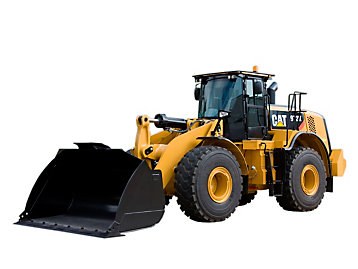New Mars Forums
You are not logged in.
- Topics: Active | Unanswered
Announcement
#26 2017-09-13 17:53:14
- SpaceNut
- Administrator
- From: New Hampshire
- Registered: 2004-07-22
- Posts: 29,479
Re: Trees
Related topic Material Choices for Mars as GW is suggesting when considering a greenhouse structure. robust enough for mars as the likelyhood of finding a flat rockless location to put the structure up on is questionable but not impossible.
Even with a sandy location the floor still needs to be able to not be penetrated by downward pressure as caused by people working to grow food within the structure but yet able to support the tray mass of soil and plants within the structure.
Post #52 or so we started to talk about construction techniques that might be applied to the creation of a greenhouse structure on mars.
Here on Earth we can get away with the use of materials such as on this page http://www.domerama.com/coverings/polycarbonate-panels/ to make a dome for use but on earth we are not presurizing them and there is no need for a sealed flooring system. Mars is not that case for how we might build.
I sort of like the thought of a corregated panel material.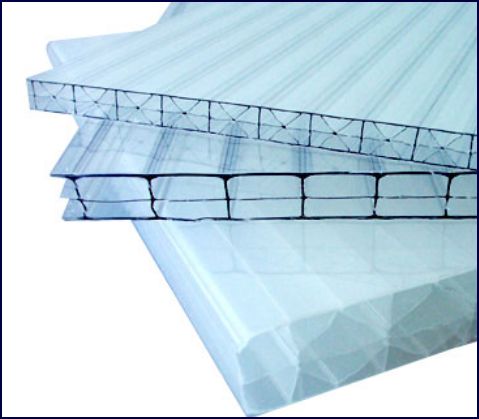
But that would mean a framing stucture to place the panels into.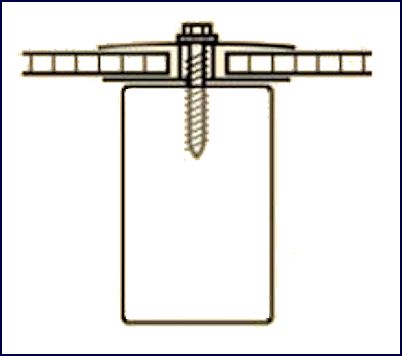
Favored materials are http://www.nationwideplastics.net/high- … tics/pctfe for use
This calculate is for a 2 V 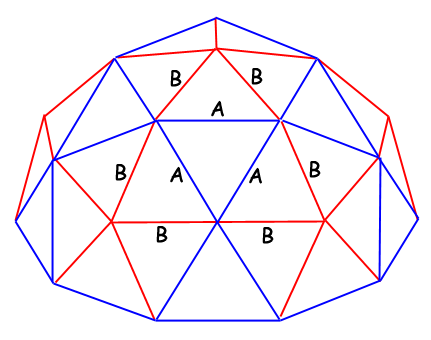
https://www.ziptiedomes.com/geodesic-do … ulator.htm
while this one is for 3 V top down view 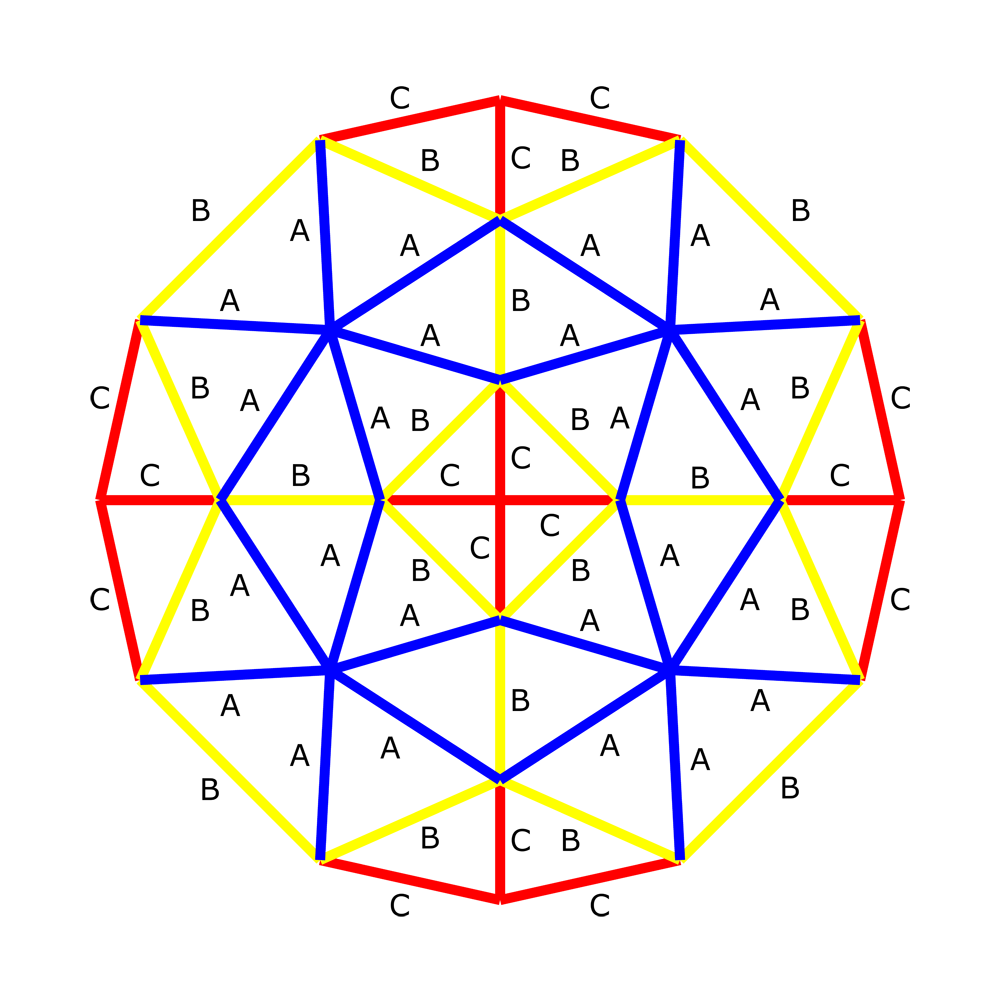 or from the side
or from the side 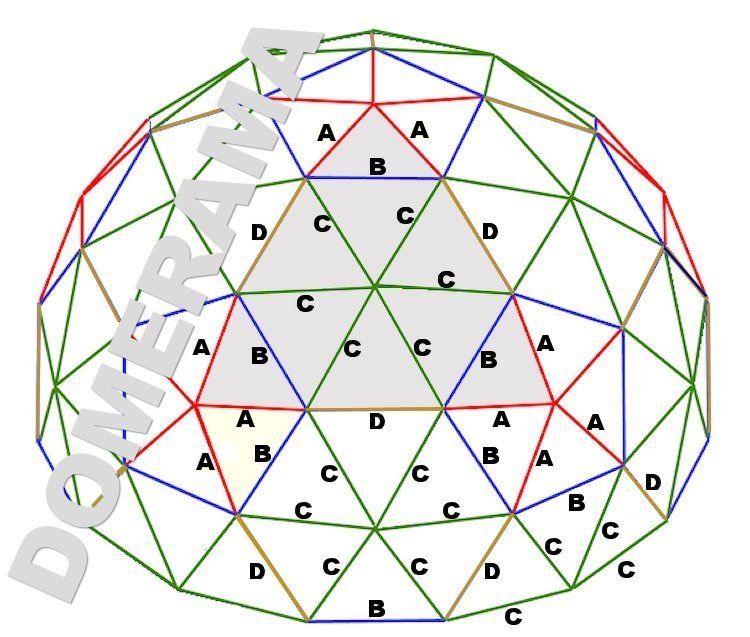
http://www.domerama.com/calculators/3v- … alculator/
Triangle shape images of them for a dome
People and tree within a dome structure size comparison table
Offline
Like button can go here
#27 2017-09-14 00:55:49
- Oldfart1939
- Member
- Registered: 2016-11-26
- Posts: 2,483
Re: Trees
In order to accommodate ANY realistic form of agriculture, we're going to need a source of motive power and lifting/digging capacity. In an earlier thread or threads, we discussed having a skid-steer/front loader type vehicle in one of the early cargo loads to Mars. Virtually every machinery company builds these but have somehow all captured the name of "Bobcat."
I for one, am strongly in favor of the hillside structure proposed by Robert, which if properly aligned w/r the sun track, allows maximum solar gain and illumination for the growing crops. As a secondary feature it can be built high enough to allow trees to flourish inside.
I also support the rigid structure as mentioned by GW, since protection from micrometeorites is essential, and polycarbonate plastic can certainly provide that. The third consideration is weight of structure versus having an integral floor to hold it down on the surface instead of being levitated away by internal pressures.
To SpaceNut: maybe we need to have a new thread here--one which attempts to unify all these concepts that growing trees has elicited? I may start something a bit later after completing the proposed organization mentally.
Offline
Like button can go here
#28 2017-09-14 08:04:46
- RobertDyck
- Moderator
- From: Winnipeg, Canada
- Registered: 2002-08-20
- Posts: 8,201
- Website
Re: Trees
skid-steer/front loader type vehicle ... Virtually every machinery company builds these but have somehow all captured the name of "Bobcat."
A company that builds large vehicles used the brand name "Cat". That name is a contraction of the word "Caterpillar", derived from their first vehicles that used tracks. Now Cat produces a lot of wheel vehicles. When I hear that name, I think of this one...
Then another company built a small skid-steer loader. Because it's small, they gave it the name "Bobcat". They also produce compact track loaders and mini track loaders, but wheeled skid-steer loaders became very popular.
Ironically, the first dozers and loaders were about the size of a Bobcat. They scaled up for highway construction during World War 2. Of course the compact ones from the 1920s were a lot smaller than the monsters of the steam era. Even in the 1960s they didn't have a safety cage, just a seat at the back. Today the brand name Bobcat has become synonymous with compact loaders like the brand name "Kleenex" with facial tissue or "Aspirin" for ASA. However, it is a brand name, other manufacturers don't use that name.
Anyway, I suggest a compact track loader for Mars. Wheeled vehicles work better on hard ground, such as paved streets. But tracks work better on loose soil and for hill climbing.
Offline
Like button can go here
#29 2017-09-14 09:48:19
- Oldfart1939
- Member
- Registered: 2016-11-26
- Posts: 2,483
Re: Trees
Robert-
I agree that the tracked vehicles are probably more suitable for the Mars application, but they also need to increase the width of the tracks to handle the loose and sandy regolith we're anticipating. Having a look at the vehicle in your picture, I can also see that the operator could possibly work w/o having a space suit style helmet on while operating the unit. That would indeed be another "plus."
Offline
Like button can go here
#30 2017-09-14 14:49:43
- GW Johnson
- Member
- From: McGregor, Texas USA
- Registered: 2011-12-04
- Posts: 5,982
- Website
Re: Trees
Let us assume for the sake of argument that (1) somebody has developed an electric, tracked backhoe machine of fairly large size and lift capacity, (2) somebody has developed a concrete substitute that can poured into forms and cured at ambient Martian conditions, and (3) that glass or plexiglass panels usable for pressure window panes exist in some standardized form.
Let us assume these things plus steel rebar are all shipped to Mars along with whatever else establishes the first permanently-occupied station.
Then you can build shirt-sleeve buildings with bounced solar lighting during the day, that also provide radiation protection and great resistance to meteor hits, wind-blown debris, or bumbling humans. These are mushroom-shaped objects with a clear ring wall around the periphery under the cap. Simple polished aluminum or stainless sheets can bounce the light.
These can be habitations or greenhouses. Or whatever you need. Dead weight contains the air pressure. We already know how to engineer slabs with grade beams, that's the roof panel, I just put the grade beams on top. The walls and columns are just compressive masonry. Bury with sand to cast the roof panel, then dig out when cured. Pile dirt on top, then pressurize when the caulk around the window panels has cured.
I posted long ago how to do this over at "exrocketman". It was the article titled "Aboveground Mars Houses", dated 1-26-2013. This should be at least as easy as building a house here out of cinderblocks. That site is http://exrocketman.blogspot.com. There is a by date navigation tool on the left. Click on 2013, then on January. It's the first thing "up" in that month of that year.
Key: you don't have to have a nearby hillside for this to work. You can build this on an excruciatingly-flat plain if need be. In other words, you can build it anywhere, there are no site restrictions.
We need the concrete and the electric Bobcat, plus a big lander to bring them and the rebar down. None of this presumes any ISRU beyond using local dirt and rocks, and ice for the water. Nor does it presume any ISPP. But your job gets easier if those things actually work as advertised. Point is, it works anyway, even if those ISRU and ISPP things don't. And they might not! You MUST allow for that!
Suspenders-and-belt, armored codpiece. That's the ticket!
GW
GW Johnson
McGregor, Texas
"There is nothing as expensive as a dead crew, especially one dead from a bad management decision"
Offline
Like button can go here
#31 2017-09-14 20:40:17
- SpaceNut
- Administrator
- From: New Hampshire
- Registered: 2004-07-22
- Posts: 29,479
Re: Trees
Trees are easily brought from earth as sapplings but the issue for mars is time to growth to allow for the fruit of that tree to become available for consumption is the really issue for man as we can not really waiting for food to grow if we are relying on it.
Continued thoughts for size of the greenhouse to be able to handle the full grown tree in the other topic.
Offline
Like button can go here
#32 2017-09-14 22:27:56
- RobertDyck
- Moderator
- From: Winnipeg, Canada
- Registered: 2002-08-20
- Posts: 8,201
- Website
Re: Trees
I have argued before that life support must be robust. This is a planet without breathable atmosphere, so life support redundancy is critical. An ambient light greenhouse is the only life support system that works during complete power failure. And the surface of Mars has half the radiation of ISS, and plants are more robust vs radiation than humans. All this means you do *NOT* bury a greenhouse underground. No mushroom head, or anything else. Living quarters for a science mission will be a tuna can with sandbags on the roof. Living quarters for a permanent hab will have much more regolith, at least 2.4 metre depth. One purpose for building into a hillside is you don't have to lift the regolith; just push down from the hill onto the pressure roof. The Mars Homestead Project came up with an atrium built into the hill, with Sun-tracking solar collector reflecting light into a light pipe. That light pipe ended with a diffuser in the ceiling of the atrium. That brings natural light inside, but it's way to little light for agriculture. The plan was some plants in the atrium, including some fruit trees, but don't expect the trees to produce a lot. Indoor plants are for aesthetics.
Wind-blown debris is not much. Mars atmosphere is very low density, it can't carry much. But I've posted before the hardness of minerals found on Mars vs glass. Tempered glass is all you need to ensure dust storms do not cause any crazing.
Vehicles? Robert Zubrin argued for methane/LOX engine vehicles, so it can use the same fuel as the ERV. The ISPP facility for the ERV can be used to produce vehicle fuel once ERV tanks are full. However, if you want an all-electric vehicle, this guy converted a Bobcat to full electric. Click image for YouTube video. Two videos, same guys. 72-volt AC motor, lithium-ion batteries.

Don't bring rebar from Earth. Use all in-situ resources for construction. Hematite concretions are perfect iron ore, can be smelted with the direct reduced iron method. That method requires both carbon monoxide (CO) and hydrogen (H2), between 800°C and 1200°C and 1 atmosphere pressure. We could go over all the steps to make rebar, but the point is ISRU.
Concrete is very useful. Getting it to set in Mars atmosphere is an issue. That needs to be worked out.
Offline
Like button can go here
#33 2017-09-15 01:12:46
- Oldfart1939
- Member
- Registered: 2016-11-26
- Posts: 2,483
Re: Trees
Robert-
What was the operating time of these Bobcats operating with Lithium Ion batteries? Any idea of the charging time? If it could operate at full load for > 1 hour, that would be useful, especially if the recharge time were short. I have an E-Go battery powered lawnmower which can run at full load for nearly an hour with a recharge time of ~ 30 minutes, so it is actually a useful tool. I also have a Ryobi weed trimmer with decent operation time between recharges. Maybe the new Graphene batteries will do better?
Offline
Like button can go here
#34 2017-09-15 04:47:57
- elderflower
- Member
- Registered: 2016-06-19
- Posts: 1,262
Re: Trees
Rebar, like so many steel products such as joists and columns, is made by rolling. It will be a very long time before there is a rolling mill on Mars.
Pure iron or nickel can be deposited from carbonyl vapours and this offers means of making large items such as iron rods, but the resulting pure iron deposit is quite soft. I suppose it could be then roughened and case hardened for use as effective reinforcement, but we are still faced with industry on a considerable scale.
A concrete dome needs no reinforcement once it is complete, provided that the outward thrust can be resisted in the foundations. Hadrian's concrete Pantheon dome is still standing in Rome after nearly two thousand years.
Last edited by elderflower (2017-09-15 04:52:17)
Offline
Like button can go here
#35 2017-09-15 15:45:32
- SpaceNut
- Administrator
- From: New Hampshire
- Registered: 2004-07-22
- Posts: 29,479
Re: Trees
There are other fuels to make use of for making insitu rebar that comes to mind one being the left over fuels from the landers, another is insitu magnesium and CO2 and I am sure there are others.
For concrete setting up use the same methods used in the cold weather repairs done of over passes or bridges here in NH which is a simple plastic tent that is heated.
In either case I think we are talking about Trees are we not....
To which we would need to solve transport and growth rates to maturity in order to make them useable as quick as we can for consumption.
Offline
Like button can go here
#36 2017-09-15 15:47:39
- GW Johnson
- Member
- From: McGregor, Texas USA
- Registered: 2011-12-04
- Posts: 5,982
- Website
Re: Trees
In my mushroom building concept, the columns have to be pre-loaded in compression so as to take bending when the building is pressurized. I rather doubt the deadload of the regolith-covered roof is enough compressive pre-load, particularly once the building is pressurized. A real civil engineer could figure this "for sure". I am not one of those. So I cannot.
That means these columns absolutely must be pre-stressed with threaded steel rods through their length, tightened to torque with big nuts and spreader washers on each end. No different than a concrete bridge beam. But the proper steel parts are required, and these aren't just rebar. Although that is necessary too, such as for shear stirrups. As well as in the roof slab with its grade beams as longitudinal bars and shear stirrups. And the foundations with their grade beams.
This kind of thing simply isn't a possible ISRU item until somebody starts building steel mills of whatever form they finally take on Mars. I'm sorry, for the first generation or two, these things just have to get shipped from Earth. To dream otherwise is just that: dreaming, not a proper plan.
Longer term, once the form of a steel mill on Mars finally "gels" and becomes a reality, the pace of construction increases, because of locally made materials. But you simply cannot do everything in just the first several missions! To expect otherwise is both unreasonable and quite naive.
Sorry, that emperor has no clothes! Naked as a peeled egg!
GW
Last edited by GW Johnson (2017-09-15 15:51:20)
GW Johnson
McGregor, Texas
"There is nothing as expensive as a dead crew, especially one dead from a bad management decision"
Offline
Like button can go here
#37 2017-09-15 20:28:39
- RobertDyck
- Moderator
- From: Winnipeg, Canada
- Registered: 2002-08-20
- Posts: 8,201
- Website
Re: Trees
Boot-strapping requires starting small. A rolling mill does not have the be the size of a full-scale industrial operation. It can be smaller. A tuna-can hab will never have anything like that, but you can build moderate. And let's be blunt, you will never send bulk heavy construction material to Mars. You have to send small items, then use that to construct moderate facilities, then use that to build industry.
Offline
Like button can go here
#38 2017-09-16 06:12:24
- elderflower
- Member
- Registered: 2016-06-19
- Posts: 1,262
Re: Trees
I do think it will be a long time before there are trees in Mars greenhouses. If large plants with structural properties are needed, Bamboo is probably the answer. For fruits we can grow bushes and dwarf trees in a modest greenhouse. Either will produce oxygen, but all plants we would contemplate will do that. Paper can be produced from ruminant faeces and probably those of rabbits as well.
Life without maple syrup is slightly diminished, but the pioneers will get by.
Offline
Like button can go here
#39 2020-09-28 05:26:07
- tahanson43206
- Moderator
- Registered: 2018-04-27
- Posts: 21,649
Re: Trees
This topic has been resting for a while. The article at the link below reports on research that provides a scientific basis for common sense.
https://www.yahoo.com/news/maple-trees- … 21918.html
As I understand the results of the study, trees with more leaves in the canopy do a better job of preventing ultraviolet radiation from reaching people in the shade below. What common sense ** cannot ** provide are numbers showing that the effectiveness of trees in the ** same ** species can vary widely.
Earlier in this topic, doubts were expressed about the success of trees on Mars, but I think that discussion over recent months has shown that architecture for Mars can provide large open spaces under pressure retaining fabric, and trees vary in size over a wide range.
https://www.yahoo.com/news/maple-trees- … 21918.html
Edit#1: I have now completed review of the topic from IanM's launch in 2017. The topic veered wildly from the theme at several points, so it covers a lot more than trees. Positions about various approaches to living on Mars haven't changed much, it seems.
I was glad to see advocates for dwarf trees, and I note RobertDyck's recollection of a dwarf orange tree in a living room. That recollection comes pretty close to matching my understanding of what is practical on Mars.
In order for this topic to progress while staying ** on topic **, it would help if contributors could find appropriate topics to post their ideas.
Since SpaceNut explained how to use the Search tool to find key words in topic titles, I've had better luck finding existing topics to go with new items.
Having said that, I recognize that is is difficult to stay ** on ** a topic devoted to trees, since trees themselves can only exist (in any numbers) on Mars if a lot of development of the environment is carried out.
(th)
Offline
Like button can go here
#40 2020-09-28 10:14:35
- tahanson43206
- Moderator
- Registered: 2018-04-27
- Posts: 21,649
Re: Trees
An experiment to set up a tree to grow on Mars would be of interest to some ...
Due to the presence of perchlorates in the regolith of Mars, I wondered if a tree could grow in a medium that includes material from Mars itself ...
A Google search for information about microbes that might actually ** like ** chlorine was productive:
Showing results for are there microbes that like chlorine (as in perchlorates)
Search Results
Web resultsAncient Life Form Breathes Rocket Fuel Ingredient | Live ...www.livescience.com › 28444-ancient-life-breathes-roc...
Apr 4, 2013 - "The use of perchlorate by early ancestral microbes might thus have been one of ... Before plants evolved, there wasn't any in the atmosphere. ... like sulfate and chlorine, by separating the oxygen from the chlorine and adding ...<snip>
Toxic Mars: Astronauts Must Deal with Perchlorate on the Red ...www.space.com › 21554-mars-toxic-perchlorate-chemi...
Jun 13, 2013 - They actually live off highly oxidized chlorine, and in reducing the chlorine ... In fact, when there's too much perchlorate in drinking water, microbes are used ... "Anybody who is saying they want to go live on the surface of Mars ...Bacterial Growth in Chloride and Perchlorate Brines ...www.liebertpub.com › doi › full › ast.2019.2069
Oct 24, 2019 - (3) P. halocryophilus shows the highest microbial sodium perchlorate ... in Mars-like environments, suggests that high-concentrated perchlorate ... indicated that perchlorate salt hydrates and their brines might play a role in the ...
by J Heinz - 2019 - Cited by 7 - Related articlesPerchlorate - Wikipediaen.wikipedia.org › wiki › Perchlorate
A perchlorate is a chemical compound containing the perchlorate ion, ClO − 4. The majority of ... Perchlorate contains chlorine in its highest oxidation number. ... microbes that grow via perchlorate reduction utilize the enzymes perchlorate ... Based on the temperature and pressure conditions on present-day Mars at the ...Mars Surface May Be Too Toxic for Microbial Life | Smart ...www.smithsonianmag.com › smart-news › mars-surface...
Jul 6, 2017 - While perchlorates, which are composed of chlorine and oxygen, are toxic to humans, microbes typically love the stuff. ... But the latest study, published in the journal Scientific Reports, suggests that in the presence of ultraviolet light perchlorate is not so microbe-friendly.Mars Surface Is Looking Much Deadlier Than We Previously ...www.sciencealert.com › mars-surface-looks-to-be-muc...
Jul 7, 2017 - A new study has revealed that compounds present in the Martian soil can wipe ... The problem here lies with perchlorates - chlorine-containing chemical ... bacteria, Bacillus subtilis, and subjected them to Mars-like conditions.Environmental Factors That Control Microbial Perchlorate ...www.ncbi.nlm.nih.gov › pmc › articles › PMC124121
These studies demonstrate that microbial respiration of perchlorate is significantly ... In general, chlorine oxyanions in the environment result from anthropogenic ... of the microorganisms involved in microbial perchlorate reduction, there is still ... Similar to these findings, CD activity in D. suillum was only observed in cells ...
by SK Chaudhuri - 2002 - Cited by 216 - Related articles
For SpaceNut ... are you aware of any discussions of this issue that may have taken place in the forum, in earlier times?
(th)
Offline
Like button can go here
#41 2021-05-18 07:10:51
- tahanson43206
- Moderator
- Registered: 2018-04-27
- Posts: 21,649
Re: Trees
An observation by RobertDyck at post #161 of the topic cited below stayed with me. It was a caution that trees need wind to stress them.
http://newmars.com/forums/viewtopic.php … 45#p178745
SearchTerm:trees need wind
Searchterm:wind needed by trees to develop strength
Failures of Biosphere II
(th)
Offline
Like button can go here
#42 2021-05-18 18:41:52
- louis
- Member
- From: UK
- Registered: 2008-03-24
- Posts: 7,208
Re: Trees
Really? In London lots of office blocks have large atriums with trees growing in them. Well, put it the other way round - how strong do they have to be if there is no wind?
An observation by RobertDyck at post #161 of the topic cited below stayed with me. It was a caution that trees need wind to stress them.
http://newmars.com/forums/viewtopic.php … 45#p178745
SearchTerm:trees need wind
Searchterm:wind needed by trees to develop strengthFailures of Biosphere II
(th)
Let's Go to Mars...Google on: Fast Track to Mars blogspot.com
Offline
Like button can go here
#43 2021-06-11 14:49:06
- Mars_B4_Moon
- Member
- Registered: 2006-03-23
- Posts: 9,776
Re: Trees
How Moon and Mars colonies could learn from Hebridean island communities – Professor Charles Cockell
https://www.scotsman.com/news/opinion/c … ll-3247630
“These regoliths are not available for plant growth experiments, therefore NASA has developed regolith simulants.
“The major goal of this project was to cultivate and harvest crops on these Mars and Moon simulants.”
The study examined ten different crop types: garden cress, rocket, tomato, radish, rye, quinoa, spinach, chives, pea, and leek and the only food source to fail was spinach.
Moon regolith has been returned to Earth but space missions have yet to bring back soil from Mars.
https://www.express.co.uk/news/science/ … space-news
Purdue Seeks to Give Astronauts Better Food in Space
https://www.insideindianabusiness.com/s … d-in-space
Gastronauts: A History of Eating in Space
https://www.mentalfloss.com/article/646 … g-in-space
Offline
Like button can go here
#44 2022-09-22 13:51:13
- Mars_B4_Moon
- Member
- Registered: 2006-03-23
- Posts: 9,776
Re: Trees
World's loneliest tree standing alone on tiny island could help climate crisis
https://www.mirror.co.uk/news/world-new … e-28021341
The 120-year-old tree is 120 miles away from its nearest neighbour in the Southern Ocean - but its location could help researchers find out crucial information about climate change
From the Moss forum discussion
Spruce Trees Are Invading the Arctic. Here’s What That Means for Our Planet.
https://www.outsideonline.com/outdoor-a … te-change/
World Oldest Trees: The Trees of Antarctica
https://www.agedwoods.com/world-oldest- … ntarctica/
Millions of years ago Antarctica was part of a landmass called Gondwana. 420 million years ago to be exact. Gondwana included Antarctica, Africa, Australia and South America as well as the Arabian Peninsula and the Indian subcontinent. It had a landmass of 39 million square miles. Eventually Gondwana and Laurasia drifted together to form Pangea around 200 million years ago.
At the time Antarctica was much further north meaning it had a much warmer climate. Tree life was common and was dominated by the Glossopteris genus of trees that could grow to 130 feet tall and had leaves larger than a person’s arm. These trees thrived until the Permian mass extinction about 250 million years ago which also killed between 70% and 90% of life on the planet and paved the way for the dinosaurs along with a variety of new tree and plant life. The continent was located on near the equator and featured a hot and dry climate that became a desert. As Gondwana broke up and Antarctica drifted south the climate cooled. Beech trees, ginkgoes and ferns became the dominant species until ice began to form around 40 million years ago and by 14 million years ago the continent was covered in ice.
There are also many topics on using Bamboos on Mars the group of evergreen perennial flowering grass plant which provide 'Wood' but grow very fast with very uniform texture.
Offline
Like button can go here
#45 2022-09-22 20:59:18
- SpaceNut
- Administrator
- From: New Hampshire
- Registered: 2004-07-22
- Posts: 29,479
Re: Trees
Of course, for mars you need a large protective canopy so as to all those that grow tall do be able to do so otherwise, we are stuck with dwarf or shrubs....
Offline
Like button can go here
#46 2022-10-25 09:11:02
- Mars_B4_Moon
- Member
- Registered: 2006-03-23
- Posts: 9,776
Re: Trees
The mixes of Woods and Poly material.
'Transparent wood could help us end our reliance on petroleum based plastics'
Offline
Like button can go here
#47 2024-05-28 16:31:31
- Mars_B4_Moon
- Member
- Registered: 2006-03-23
- Posts: 9,776
Re: Trees
Japan constructs world's 1st wood satellite, launch possibly in Sept.
https://mainichi.jp/english/articles/20 … sc/045000c
Japanese researchers said Tuesday that they have successfully constructed the world's first wooden satellite, with the tiny cube-shaped object expected to be sent into space aboard a SpaceX rocket launched from the United States, possibly in September.
"LignoSat," a blend of the words ligno, a prefix meaning wood, and satellite, is the outcome of about four years of development efforts by a team involving Kyoto University and Sumitomo Forestry Co., with the aim of harnessing the environmental friendliness and low cost of wood in space development.
Offline
Like button can go here
